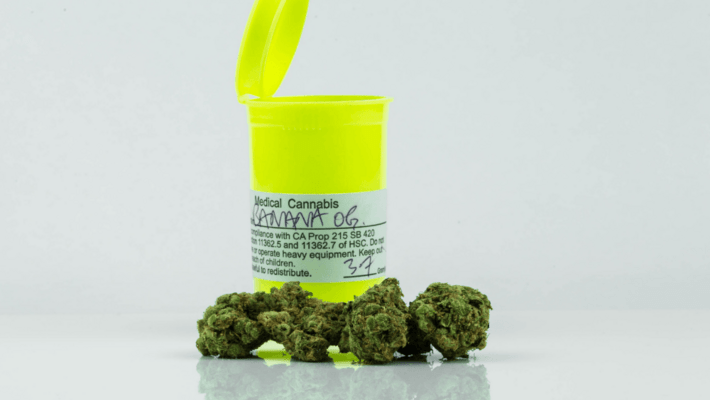
Why High-THC Cannabis Rules the Marijuana Market
Published on 10/26/20
No matter which legal cannabis state you are in, most cannabis dispensaries have an extensive menu that goes on for pages. With so many strains, vape pens, topicals, resins, rosins and other options to choose from, it can be hard for customers to know what they want. Likewise, it can be difficult for dispensary owners to provide a range of products that are all successful. With so much to choose from, how do customers know what to pick? For most cannabis consumers, high THC percentages tend to inform their purchase. So why does THC percentage rule the day in cannabis product comparisons? How much THC is in weed? What is considered high-THC weed? Why is proper cannabis lab testing so important, and is the metric even an indicator of how good the flower is? We've got you covered on all that and more in our guide to high-THC trees.
What Does THC Percentage Mean in Flower?

In the simplest terms, the THC percentage is a representation of each batch of flower's potency. Tetrahydrocannabinol - or THC for short - is the main psychoactive chemical in cannabis, and is generally responsible for the intoxicating high or stoned effects that we expect from weed. As states began to legalize weed and cannabis sales moved from the black market into the green rush, product testing for potency and safety became standard, and THC percentages became an easy way for consumers to try and pick out the strongest strain possible.
Just 10 years ago, cannabis varieties with THC percentages in the high-teens were considered high-THC strains. At that time, breaking 20% THC was a marker of high-grade, extra strength bud. Now, with 11 states fully legal and 33 states with medicinal marijuana, the low 20% range is considered average THC percentage in flower, with top-shelf strains regularly testing well above 30% THC.
Over the past two years, multiple records have been set when it comes to high-THC flower. In 2018, thePortland Mercuryreported that a local Oregon cultivator grew a strain named Future (#1) that tested at a whopping 37.28% THC. In 2019, that record was broken - but just barely - by multi-state cultivator GTI, which reportedly grew the current highest THC strain ever, a batch of their Indica-dominant Brownie Scout strain grown in Illinois tested at 37.5% THC.
Why Do Customers Prefer Strains With High-THC?

As more and more people visit cannabis dispensaries and experiment with marijuana, THC percentage has emerged as an easy indicator of perceived quality and value. Especially as old standard strains like OG Kush and Sour Diesel give way to a neverending stream of new genetic concoctions, looking at THC test results gives consumers a reference point to compare and contrast products. And just like consumers go for super-sized meals and high ABV beers, a lot of cannabis consumers are simply looking for the most bang for their buck. Because cannabis is usually priced by the grower, cultivation style, or availability and typically not by THC quantity, finding a flower with the highest THC quantity is seen by many as the wisest way to spend their dollar.
Broken down in the most logical sense, if you have the option of buying a gram of weed testing at 15% THC or a gram testing at 30% THC, theoretically, if you rolled the latter bud into a blunt, it would get you twice as high as the former. Or, if you prefer conservation, the high-THC bud could potentially last you twice as long as the mid-grade counterpart. Unfortunately, the true nature of marijuana's effects isn't nearly that simple.
How Dispensaries Can Highlight Low-THC Strains to Customers
It might seem hard for budtenders to convey to dispensary customers, but high THC percentages are not the be-all-end-all determining factor in the quality of cannabis flower. Sure, 30% THC weed will likely get you more stoned than the same quantity of 15% bud, but every person's body interacts with THC differently and the assumption that it would cause double the intoxication has not been proven clinically. One recent study found that high THC levels in cannabis concentrates did not necessarily indicate higher levels of intoxication.
Educate Budtenders on ALL Products

While high-THC flower often sell quite well, it's incredibly important that budtenders can speak to lower THC products, too. A study done by BDS Analytics found that edibles consumers often wanted low-dosage edibles, containing less than 10mg of THC. With this in mind, dispensaries should teach budtenders about all of the other benefits of low-THC products.One important aspect of cannabis is terpenes. The naturally occurring flavonoids not only give each strain its distinct smell and taste but also interact with cannabinoids to accentuate and influence your high. According to terpene effect charts like this one from Encore Labs, terps like myrcene and terpinolene are great for sedation and relaxation, while limonene and pinene can help you elevate your mood and stay awake and attentive. If you are looking for a great nighttime bud, a joint full of flower with 20% THC and a high percentage of myrcene will probably do the trick better than a bowl of 30% THC weed packed with limonene.
Similarly, strains low in THC but high in CBD, CBG, CBNand other lesser-known cannabinoids can be great for relaxation without the intense intoxication of high-THC bud. For many users, high-THC weed is attractive due to its status but can lead to anxiety or overconsumption. Low and medium levels of THC allow users to gradually consume without going overboard. Often, moderation is the key when it comes to enjoying your cannabis experience.
Do you seek out the highest THC quantities when you shop for weed at the dispensary, or do you look for terpene profiles and minor cannabinoids? Let us know in the comments below!
